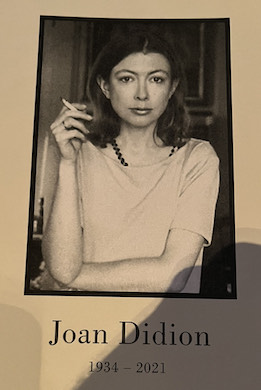A Royal Goodbye for Joan Didion
‘Joan,’ the bicoastal magician with a typewriter whose spare style and sharp eye made her one of the defining essaysists of the 20th century, is memorialized at New York City.

A second queen was memorialized this week when “A Celebration of the Life of Joan Didion,” organized by Penguin Random House, was held at the Cathedral of St. John the Divine, on 112th Street. It began with the Very Reverend Patrick Malloy speaking, and ended with Patti Smith singing.
In between, a bevy of worthies took to the microphone to address a crowd that spilled down the nave and stretched toward the altar as far as could be seen. They were there for “Joan,” the bicoastal magician with a typewriter whose spare style and sharp eye made her one of the defining essaysists of the 20th century. Essays like “Slouching Towards Bethlehem,” “Dreamers of the Golden Dream,” and “Goodbye to All That” are landmarks.
Didion spent her early years at Vogue before becoming closely tied to the New York Review of Books, where her attention swiveled to the political scene. In nonfiction and novels, she pursued a form of journalism that many saw as characterized by literary artistry. Out of the public eye in her later years and confined to her Upper East Side perch, Didion captured new audiences with the popularly and critically acclaimed “Year of Magical Thinking.”
Didion was a writer who moonlighted as an icon. It was all there: her cigarette and sunglasses, her voice and her vibe, the beauty of her cheekbones and her prose, the way she appeared to hold the quintessence of both New York and Los Angeles. If the counterculture she chronicled was hot, she was cool — admired by the ink-stained New York writers and the beautiful denizens of the dream planet of Hollywood, treasured by the Rolling Stones.

The stars came out for her, this last time. Justice Anthony Kennedy, the high court’s last swing vote and now retired from the bench, was a childhood friend of Didion at Sacramento, and recalled her pensive presence at schooldays parties, then rushing home to scrawl down impressions. He reflected that it was her work that taught him to interrogate, before each judicial decision, “Why am I doing this?”
Governor Jerry Brown, who knew Didion well in California and appeared via video, quoted her aspiration to capture “the whole grand pattern of human endeavor.” The editor in chief of the New Yorker, David Remnick, lamented that his magazine was rarely her first choice — her loyalty to the NYRB was strong — and mourned not only the loss of the 87-year-old Didion but her generation of writers: “The cathedral is full of ghosts,” he noted.
Mr. Remnick marveled at the sharpness of her prose and noted that young writers “study her sentences the way young artists study Rembrandt.” He paused as he recalled her “particular music,” the sound of a Didion sentence being as clear as a bell and as precise as a missile. One of Mr. Remnick’s prized writers, Jia Tolentino, expressed a yearning for a “Didion road map” as she hunts the “flash of gold” in her own work.
Another New Yorker mainstay, Hilton Als, is curating an exhibition of Didion’s work to be shown at the Hammer Museum at Los Angeles. He evoked her poise as she wrote of the “cracked, chaos filled kingdom” that stretched from coast to coast. A childhood friend of Didion’s daughter, Quintana, spoke of a different, more intimate pair of cracks: Didion lost both her husband and Quintana in 2003, in a double punch of grief.
The model and novelist Susanna Moore recalled that Didion proclaimed, “Evil is the absence of seriousness,” after a dinner where Bianca Jagger spent the entirety of the meal leafing through magazines rather than engaging in conversation. Her nephew, Griffin Dunne, remembered that when required to appear before cameras, Didion “hit the light every time.” This last light, for the last time, shone through stained glass and saints.

